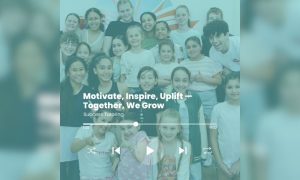All about English Literary Techniques
English literary techniques, also known as literary devices or figures of speech, are tools that writers use to enhance their writing and convey meaning in a creative and impactful way. They can evoke emotions, create vivid imagery, emphasise key ideas, and engage readers on multiple levels.
This blog will combine the most common English literary techniques used in texts.
For each technique you will find:
- a definition
- the effect
- examples
Allegory
An allegory is a story, poem, or painting in which the characters, events, objects, persons, or actions are symbols of something else. The purpose of an allegory is to communicate complex ideas or concepts in a more accessible and engaging manner. It allows writers, artists, or creators to explore and comment on various themes, such as human nature, morality, society, religion, or political ideologies, through metaphorical representation.
Examples
- “The Wizard of Oz” by L. Frank Baum: This children’s novel, famously adapted into a movie, can be seen as an allegory for the political and economic issues in America during the late 19th century.
- “The Lion King” (Disney film): This animated film can be interpreted as an allegory for the circle of life, leadership, and the hero’s journey. The characters and events parallel Shakespeare’s play “Hamlet,” with Simba representing the rightful king overcoming his internal struggles and reclaiming his place in the natural order.
- “Everyman”: This medieval morality play is an allegory that depicts the journey of a character named Everyman who represents humanity.
Alliteration
Alliteration is a literary device that involves the repetition of initial consonant sounds in neighbouring words or stressed syllables within a phrase or sentence. The primary purpose of alliteration is to add rhythm, musicality, and a sense of cohesion to a piece of writing. By repeating the same consonant sounds at the beginning of words or stressed syllables, alliteration can create a pleasing and melodic effect.
Alliteration is commonly used in poetry, prose, and rhetoric to create specific effects. It can be used to evoke a particular mood or atmosphere, add emphasis to certain words or ideas, or create a sense of unity within a sentence or passage. It is also often used in slogans, advertising, and branding to make phrases more catchy and memorable.
Examples
- “Peter Piper picked a peck of pickled peppers.” (from a tongue twister).
- “She sells seashells by the seashore.” (a famous example of alliteration).
- “Big, bold, and beautiful.” (alliteration used for emphasis).
Allusion
An allusion is a literary device that refers to a person, place, event, or literary work, either explicitly or indirectly. Allusions are often used by writers to enhance their work by drawing upon existing cultural, historical, or literary knowledge. By referencing well-known characters, stories, or events, the writer can evoke certain emotions, provide additional layers of meaning, or make connections between different works or ideas.
Examples
- “He was a real Romeo with the ladies.” (referring to the romantic character Romeo from Shakespeare’s play “Romeo and Juliet”).
- “She’s a Pandora’s box of secrets.” (referring to Pandora from Greek mythology, whose curiosity led her to open a box containing all the world’s evils).
- “His strength was like that of Hercules.” (referring to the mythological hero Hercules known for his immense strength).
Analogy
An analogy is a comparison between two or more things that are similar in some respects but different in others. It is a literary device that helps to explain or clarify a complex idea or concept by drawing parallels to something more familiar or easily understood.
The purpose of an analogy is to make a comparison that highlights the similarities between the two subjects, allowing the reader or listener to better grasp the characteristics, qualities, or relationships being discussed.
Examples
- “Life is like a roller coaster; it has its ups and downs.” This analogy compares the ups and downs of a roller coaster ride to the various experiences and challenges one encounters in life.
- “Time is money.” This analogy suggests that time, like money, is a valuable resource that should be used wisely and efficiently.
Anecdote
An anecdote is a short and often amusing or interesting story about a real person, incident, or event. It is a brief narrative that is usually based on personal experiences, observations, or anecdotes shared by others. They are commonly used in conversation, speeches, or writing to illustrate a point, provide examples, or entertain the audience.
Examples
- “When I was in high school, I had a teacher who was notorious for his strictness. One day, he caught a student sleeping in class. Without saying a word, he grabbed a piece of chalk and threw it at the sleeping student, hitting the wall right next to his head. Needless to say, we all stayed wide awake in that class from then on.
Cliche
An overused, common expression.
Examples
- “Love is blind.”
- “Actions speak louder than words.”
- “In the blink of an eye.”
- “Better late than never.”
Colloquialism
Colloquialism refers to a word, phrase, or expression that is characteristic of informal, everyday language used in casual or familiar conversations. Colloquialisms are an integral part of informal communication and can add a sense of familiarity and relatability to conversations.
Examples
- “Hit the sack” (go to bed).
- “Piece of cake” (something easy or effortless).
- “Wanna” (short for “want to”).
Contrast
Contrast refers to the comparison or juxtaposition of two or more different elements, characteristics, or concepts to highlight their differences. Contrast plays a crucial role in enhancing the richness and complexity of communication by allowing for the exploration of different perspectives, highlighting differences, and stimulating critical thinking. It helps to create depth, variety, and visual or conceptual impact by juxtaposing contrasting elements.
Examples
- Light and Dark: The stark contrast between light and dark is commonly used in literature and art to symbolise good versus evil or hope versus despair.
- Love and Hate: Contrasting the emotions of love and hate can be a powerful literary device. By juxtaposing these extreme emotions, writers can emphasise the intensity and impact of each, revealing the complex range of human emotions.
Dialogue
Dialogue refers to a conversation or exchange of spoken or written words between two or more individuals. In theatre, film, and television, dialogue is crucial for storytelling, as it drives the narrative, develops characters, and engages the audience. Well-written dialogue can be dynamic, authentic, and reflective of the characters’ personalities and motivations.
Examples
- casual conversations.
- movie dialogue.
- literary dialogue.
Ellipses
Ellipses, denoted by three consecutive dots (…), are punctuation marks used to indicate the omission of words, a pause, or a trailing off of thought in a written text. They are often used to create a sense of suspense, uncertainty, or to convey a particular tone or mood.
Examples
- “I’m not sure what to say… it’s just so unexpected.”
Emotive language
Emotive language refers to words or phrases that are used deliberately to evoke an emotional response or create a specific emotional impact on the reader or listener. It is characterised by its ability to appeal to the emotions, feelings, and personal experiences of the audience.
By using words with strong connotations, vivid imagery, and powerful associations, emotive language has the potential to make a piece of writing or speech more engaging, memorable, and persuasive. It appeals to the values, desires, fears, and aspirations of the audience, tapping into their emotional reservoirs to create a deeper connection and influence their perception or behaviour.
Examples
- “Heartwarming”: This word creates a positive emotional response, suggesting something touching, uplifting, or inspiring.
- “Tragic”: This word evokes a sense of sadness, loss, or sorrow, aiming to elicit empathy or sympathy from the audience.
- “Terrifying”: This word instills fear or creates a sense of intense danger or horror, aiming to provoke a strong emotional reaction.
Exclamation
An exclamation is a linguistic expression used to convey strong emotions, such as surprise, excitement, joy, anger, or pain. It is characterised by its loud or emphatic delivery and typically ends with an exclamation mark (!) in written form.
Examples
- “Wow! That’s incredible!”
- “Oh no! I can’t believe it!”
- Foreshadowing.
Foreshadowing is a literary technique in which an author provides hints, clues, or indications of future events or developments in a story. It is used to create anticipation, build suspense, and prepare the reader or audience for what may happen later in the plot.
Examples
- Romeo and Juliet by William Shakespeare: In the prologue of the play, the chorus foreshadows the tragic fate of the star-crossed lovers by saying, “A pair of star-cross’d lovers take their life.
Form
Structure and features of a text which influences its intended meaning
Examples
- poem following strict sonnet form.
Fragmented sentences
Are incomplete sentences that lack a subject, a verb, or both, and do not express a complete thought. They are usually considered grammatically incorrect on their own however, they can be used intentionally in creative writing or informal contexts to create a specific effect or emphasise a certain point.
Examples
- “Running through the fields, enjoying the sunshine.”: This sentence lacks a main verb and does not express a complete thought. It could be rewritten as “I was running through the fields, enjoying the sunshine.”
Hyperbole
Hyperbole is a figure of speech that involves exaggerated statements or claims that are not meant to be taken literally. It is used for emphasis, humour r, or to create a dramatic effect. By intentionally exaggerating something, hyperbole draws attention, creates impact, and adds intensity to the message being conveyed.
Examples
- “I’m so hungry, I could eat a horse!”
- “I’ve told you a million times!”
- “This bag weighs a ton!”
Imagery
Imagery refers to the use of vivid and descriptive language that appeals to the reader’s senses, creating mental images and sensory experiences. It engages the reader’s imagination and helps to convey a more vivid and detailed depiction of people, places, objects, or events.
Examples
- “The golden sun sank below the horizon, painting the sky with hues of pink and orange.”
- “The waves crashed against the shore, their roar filling the air.”
- “The scent of freshly baked bread wafted through the kitchen.”
Irony
Irony is a literary device or rhetorical technique that involves a contradiction between what is expected and what actually occurs, or between what is said and what is meant. It often creates a gap between appearance and reality, leading to an unexpected or humorous outcome.
Examples
- “What a beautiful day!” said sarcastically during a heavy rainstorm.
- “Oh, fantastic! I can’t wait to spend my weekend doing chores,” said with a tone of sarcasm.
- In a play, the audience knows that a character is hiding in the closet while other characters are searching for them, creating dramatic irony.
Juxtaposition
Juxtaposition is a literary technique that involves placing two contrasting elements side by side for the purpose of comparison or contrast. It creates a striking effect and highlights the differences or similarities between the juxtaposed elements. The purpose of juxtaposition can be to emphasise certain qualities, create tension, or provoke thought.
Examples
- A child playing in a polluted, industrialised city: This contrast juxtaposes the innocence of the child with the corrupt and polluted environment, highlighting the impact of society on purity.
- “O heavy lightness, serious vanity, Misshapen chaos of well-seeming forms!” (William Shakespeare, Romeo and Juliet): This line juxtaposes the conflicting emotions of love (“heavy lightness”) and hatred (“misshapen chaos”), underscoring the tumultuous nature of the characters’ emotions.
Motif
A motif is a recurring element, image, symbol, theme, or idea that helps to develop and convey the central message or theme of a work.
Examples
- In “The Great Gatsby” by F. Scott Fitzgerald, the motif of light and darkness is used to symbolize the contrast between illusion and reality, wealth and corruption.
- In Shakespeare’s plays, the motif of light and darkness is often employed to represent the dichotomy of good and evil or to create a sense of mystery.
Metaphor
A metaphor is a figure of speech that compares two different things by stating that one thing is another, without using “like” or “as.” It creates a direct association between two unrelated concepts, often to convey a deeper meaning or create a vivid and imaginative description.
Examples
- “He is a shining star.”: This metaphor compares a person to a star, suggesting that the person possesses qualities such as brilliance, talent, or popularity.
- “Her voice is music to my ears.”: This metaphor compares the sound of someone’s voice to the beauty and pleasantness of music, emphasising its pleasing qualities.
Onomatopoeia
Onomatopoeia is a literary device that refers to words or phrases that imitate or evoke the sound associated with the object or action they describe. Essentially, it is when a word sounds like what it represents. Onomatopoeic words create a vivid auditory image, enhancing the sensory experience of the reader.
Examples
- “Crash” – The word “crash” imitates the sound of a collision or something breaking.
- “Hiss” – The word “hiss” imitates the sound of a snake or steam escaping.
- “Sizzle” – The word “sizzle” imitates the sound of something frying or sizzling on a hot surface.
Paradox
A paradox is a statement or situation that appears contradictory or absurd but may reveal a deeper truth or meaning. It often involves two seemingly contradictory ideas or concepts that, when examined closely, reveal an unexpected or ironic relationship.
Examples
- “Less is more.”: This paradox suggests that simplicity or having less can sometimes be more effective, powerful, or meaningful than having more.
- “You have to be cruel to be kind.”: This paradox highlights the idea that sometimes, being harsh or tough in the short term can be beneficial or ultimately kind in the long run.
Pathetic fallacy
Pathetic fallacy is a literary device in which human emotions, characteristics, or intentions are attributed to nature, inanimate objects, or animals. It involves giving non-human entities or phenomena human-like qualities, often to create a sense of empathy or to reflect the emotional state of a character or a situation.
Examples
- “The angry clouds loomed over the desolate landscape.”: In this example, the clouds are personified as “angry,” reflecting the tense or foreboding atmosphere.
- “The playful sunbeams danced on her face.”: The sunbeams are personified as “playful,” evoking a sense of joy or happiness.
Personification
Personification is a literary device that attributes human qualities, characteristics, or actions to non-human entities, such as animals, objects, or abstract concepts. By personifying these non-human entities, writers bring them to life and make them relatable to the reader. It is a form of figurative language that adds depth and vividness to descriptions and narratives.
Examples
- “The stars danced playfully in the moonlit sky.”: Stars are given the human quality of dancing, suggesting their lively and joyful movement.
- “The wind whispered through the trees.”: The wind is personified as whispering, as if it has the ability to communicate like a human.
- “The sun greeted me with a warm smile.”: The sun is personified as greeting with a smile, giving it human-like characteristics.
Quatrain
A quatrain is a stanza or a verse in a poem consisting of four lines. Quatrains can have various rhyme schemes, but one common form is the AABB or ABAB rhyme scheme, where the first and second lines rhyme with each other, and the third and fourth lines rhyme with each other.
Examples
- (ABAB rhyme scheme): “Shall I compare thee to a summer’s day? Thou art more lovely and more temperate: Rough winds do shake the darling buds of May, And summer’s lease hath all too short a date.” – William Shakespeare
Repetition
Involves the intentional repetition of certain elements to make them more memorable, rhythmic, or powerful.
Examples
- “I have a dream that one day this nation will rise up… I have a dream that my four little children will one day live in a nation where they will not be judged by the colour of their skin but by the content of their character.” – Martin Luther King Jr: In this famous excerpt from Martin Luther King Jr.’s “I Have a Dream” speech, the phrase “I have a dream” is repeated for emphasis and to convey the central theme of his message.
Rhyme
Rhyme is a literary device that involves the repetition of similar sounds, typically at the end of words, in a poem or song. Rhyme is often used to create a pleasing or memorable effect, enhance the flow of language, and establish a pattern within the text.
Examples
- “I wandered lonely as a cloud That floats on high o’er vales and hills. When all at once I saw a crowd, A host of golden daffodils.” – William Wordsworth
Satire
Satire is a literary device or genre that uses humour, irony, exaggeration, or ridicule to criticise or mock individuals, institutions, society, or human behaviour. It often aims to bring attention to flaws, vices, or absurdities in order to provoke change, inspire reflection, or highlight social issues.
Examples
- “The Simpsons” (TV show): This long-running animated series uses satire to critique various aspects of American culture, politics, and society. The show employs humor and satire to address topics such as consumerism, politics, religion, and family dynamics.
Setting
In literature, the setting refers to the time, place, and social or cultural context in which a story takes place. It helps establish the backdrop against which the events of a narrative unfold and can greatly influence the mood, atmosphere, and overall meaning of a literary work. The setting provides readers with a sense of the physical environment, historical period, and societal norms in which the characters exist.
Examples
- “To Kill a Mockingbird” by Harper Lee: The novel is set in the fictional town of Maycomb, Alabama, during the 1930s, a time when racial tensions and prejudice were prevalent. The setting plays a crucial role in exploring themes of racism, injustice, and the loss of innocence.
Simile
Simile is a figure of speech that involves comparing two unlike things using the words “like” or “as.” It highlights similarities between the compared elements to create vivid imagery and enhance the reader’s understanding or perception of a subject.
Examples
- “He’s as brave as a lion.”: This simile compares someone’s bravery to that of a lion, emphasizing their courage and fearlessness.
- “Her smile is like sunshine.”: This simile compares a person’s smile to sunshine, suggesting that it is radiant, warm, and uplifting.
- “The water shimmered like a mirror.”: This simile compares the appearance of water to that of a mirror, implying that it was smooth, reflective, and gleaming.
Soliloquy
A soliloquy is a literary device in which a character speaks their thoughts aloud, usually when they are alone on stage or in a situation where they believe they are alone. It allows the audience or reader to gain insight into the character’s innermost feelings, motivations, conflicts, or dilemmas. Soliloquies often reveal a character’s true nature, provide commentary on events, or advance the plot by conveying important information.
Examples
- “To be, or not to be, that is the question…”: This soliloquy from William Shakespeare’s play “Hamlet” is spoken by the title character. Hamlet reflects on the nature of life, death, and the struggles of existence.
- “Is this a dagger which I see before me…”: This soliloquy is from Shakespeare’s play “Macbeth.” It is spoken by Macbeth as he contemplates the murder of King Duncan and the consequences of his actions.
- “O Romeo, Romeo, wherefore art thou Romeo?”: Juliet’s soliloquy in Shakespeare’s play “Romeo and Juliet” expresses her longing for Romeo and her frustration with the constraints of their families’ feud.
Symbolism
Symbolism is a literary device in which an object, person, situation, or action is used to represent a deeper meaning or idea beyond its literal interpretation. It involves the use of symbols to convey abstract concepts, themes, or emotions, adding layers of depth and richness to a literary work.
Examples
- The Dove: In many cultures, the dove is a symbol of peace. In literature, it is often used to represent harmony, purity, and tranquility.
- The Mockingbird: In Harper Lee’s novel “To Kill a Mockingbird,” the mockingbird symbolizes innocence and compassion. Atticus Finch states that it is a sin to kill a mockingbird because they only bring beauty and music into the world, without causing harm.
Tense
In grammar, tense refers to the form of a verb that indicates the time of an action or event. English has three primary tenses: past, present, and future. Overall, the choice of tense as a literary device can influence the reader’s experience of the story, shape the narrative structure, and convey the author’s intended tone and mood. By manipulating time and utilising different tenses, writers can enhance the storytelling and engage readers on multiple levels.
Examples
- Past Tense: She walked to the park yesterday.
- Present Tense: I write a letter to my friend.
- Future Tense:She will finish her project tomorrow.
Theme
In literature, theme refers to the central idea, message, or underlying concept explored in a literary work. It is the overarching meaning or insight that the author wants to convey to the reader. Themes are often abstract and universal, dealing with human experiences, values, and emotions. They provide depth and significance to a story, allowing readers to connect with the characters and events on a deeper level.
Examples
- Love
- Good vs evil
- Coming of age
Tone
In literature, tone refers to the author’s attitude or emotional expression towards the subject matter, characters, or events within a literary work. It sets the overall mood or atmosphere of the piece and influences the reader’s perception and response to the text. The tone can be conveyed through the author’s choice of words, imagery, syntax, and other literary devices.
Examples
- Euphoric: The tone is ecstatic, joyful, and enthusiastic.
- Melancholic: The tone is sad, mournful, and reflective.
- Suspenseful: The tone is tense, mysterious, and filled with anticipation.
- Humorous: The tone is light-hearted, amusing, and comical.
Book a free assessment at your nearest Success Tutoring centre today!
Ready to unlock your child’s full potential in English? Book a free assessment at your nearest Success Tutoring centre today!Our team of expert tutors is dedicated to helping students excel in reading, writing, and critical thinking. Whether your child needs support in grammar, vocabulary, or literature analysis, we have a tailored program to suit their unique learning style and goals.With our personalised approach and engaging curriculum, we create a nurturing environment where your child can build confidence, improve their language skills, and develop a lifelong love for learning!Don’t let academic challenges hold your child back. Empower them to succeed in English and beyond. Take the first step towards their educational success by scheduling a free assessment now.Give your child the gift of knowledge and watch them soar to new heights in their academic journey. Let’s make learning English a rewarding and enjoyable experience together!





